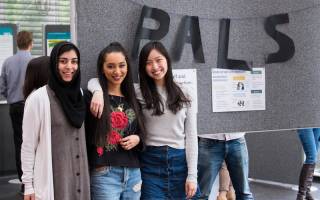The chance to connect with cutting-edge research, a diverse and international cohort of students and with staff at the top of their fields is the cornerstone of a UCL education.
Why 'creating connections'?
The opportunity to create connections is one of the most crucial aspects of a university experience and can include:
- Connections with peers;
- Connections with staff;
- Connections across levels or programmes of study;
- Connections across disciplinary groupings;
- Connections to cutting-edge research;
- Connections between theory, practice and some of the most pressing challenges our society faces;
- Connections out into industry and with the wider world.
Understanding what those connections should look like from the current student perspective is important to ensure that our education is enabling students to learn and feel part of something bigger than just being a student on a course.
Connections build Learning Communities and a sense of belonging
Learning Communities involve people learning together in groups and socially constructing knowledge. This positions learning as a social process - rather than an individual activity – through which learners must interact, analyse, negotiate, communicate and share with others who may have different views and backgrounds.
Watkins (2005) tells us that a community is a collective with certain hallmarks:
- Agency: members decide, review.
- It is where belongingness develops.
- Cohesion amongst members emerges.
- Diversity is embraced rather than seen as a difficult.
Learning communities, therefore, are an important part of student learning but also helps develop a sense of connectedness to their cohort/department/faculty/institution, where they feel valued and respected. Thomas (2012) also reminds us that belonging is intrinsically linked to success, offering us this refined definition of what success means:
“It has become increasingly clear that success means helping all students to become more engaged and more effective learners in higher education, thus improving their academic outcomes and their progression opportunities after graduation (or when they exit higher education).” (Thomas, 2012).
Why is this theme a priority for students?
In the NSS results for 2022, 60.8% of students agreed with the statement “I feel a part of a community of staff and students”. This is up from 54.4% from 2021, but it is still below the sector.
Addressed in the Student Priorities for Wellbeing Report 2022 and UCL’s Student Health and Wellbeing Strategy 2019-21, the term ‘wellbeing’ is defined as:
“A state of physical, mental, and emotional health where a student is able to engage meaningfully in learning and contribute to their community. Wellbeing is personal and multifactorial, but typically includes feelings of being socially connected, a sense of direction and belonging, satisfaction with personal achievements, and low levels of anxiety.”
What does this look like in practice?
- Minimise learning that creates isolation;
- Small group learning;
- Students bring in their experiences;
- Co-produce (do something active together);
- Quality and quantity of interactions;
- Aligned with Learning Outcomes so students are motivated to engage.
 Close
Close


